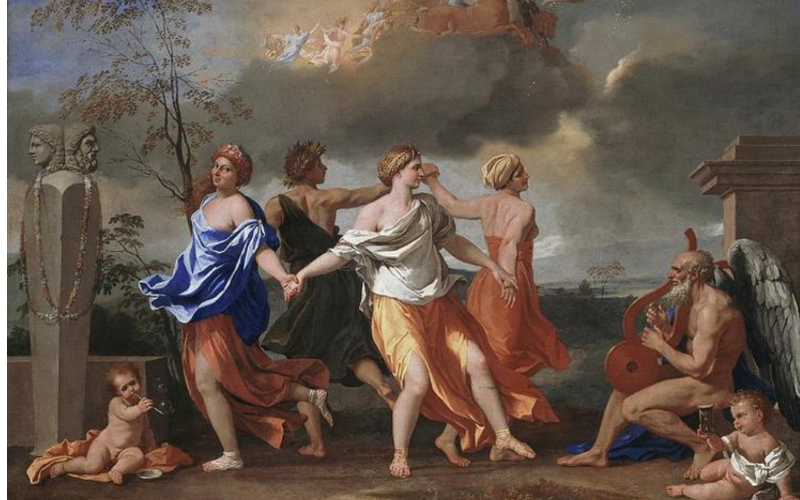Nicolas Poussin’s painting A Dance to the Music of Time is housed in the Wallace Collection in London. It was painted between 1634 and 1636 as a commission for Giulio Rospigliosi (later Pope Clement IX), who dictated its detailed iconography, according to Gian Pietro Bellori. The identities of the figures are still unknown, according to various accounts.
About Dance to the Music of Time painting
The painting is well known for inspiring the novel cycle A Dance to the Music of Time, though this title first appeared in a Wallace Collection catalogue in 1913. Previously, it was given titles referencing the Four Seasons. It was titled La Danse des Saisons, or the Image of Human Life, in the 1845 auction.
Four figures dance in a circle, holding each other’s hands, while Time plays a lyre on the right. The scene is set in the early morning, with Aurora, the goddess of dawn, preceding Apollo’s chariot in the sky behind him; the Hours accompany him, and he holds a Zodiac ring. Rospigliosi, according to Bellori, created the subject.
Poverty, Labor, Riches, and Pleasure or Luxury are the four dancers represented, beginning with the one in the back seen mostly from behind. These represent a progression in human life, with Pleasure or Luxury leading back to Poverty.
Anthony Blunt’s suggestion that, unusually for a group of the seasons, Autumn/Poverty at the back of the group was male is now widely accepted, and the museum refers to him as Bacchus. This is based on the story invented by Boitet de Frauville in his Les Dionysiaques, according to which Jupiter gave the world Bacchus and his wine in response to complaints from the Seasons and Time in order to compensate for the miserable living conditions mortals must endure.
André Félibien, Poussin’s friend and biographer, explained the painting in similar terms, except that where Bellori identified Summer with Luxury, Félibien identified it with Pleasure.
Malcolm Bull disputes these identifications, at least as the original intent. He attributes the painting‘s iconography to the Late Greek poet Nonnus, as reflected in Pierre de Ronsard’s Hymne de l’Automme. Poussin closely follows Nonnus’ descriptions of the four seasons, as translated into French: “on the left is Spring, with a garland of roses in her hair; at the back is Autumn, whose hair has been cropped by the winds but whose brow is wreathed with olive branches; Winter is next, with her bound hair and shadowed face, and at the front is Summer, dressed in white with ears of corn in the braids of her hair.”
Bacchus himself appears in the herma at left, in his dual appearance as a young and old figure. Bull believes that the other interpretation was invented “during or after its completion” by Rospigliosi, an intellectual and author with a penchant for allegory, whereas Ingamells believes that “Poussin was not unduly concerned with the precise identification of the figures.”











